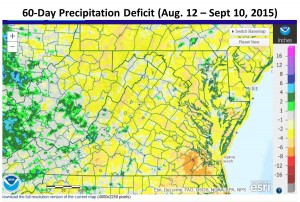Virginia Soybean Variety Test yield data are now available and can be found at my website – Virginia Soybean Extension & Research.
If you have comments or questions, please contact me.

Virginia Soybean Variety Test yield data are now available and can be found at my website – Virginia Soybean Extension & Research.
If you have comments or questions, please contact me.

I had never seen fields as wet as they were back in the second week of July. But, things change very rapidly.
In August, it appeared that full-season yield potential was 60 to 80 bushels per acre. Growth was excellent and the crop was loaded with pods and seed. Likewise, corn yield potential was excellent. Double-crop soybean did not look nearly as good, struggling with general poor growth due late planting, wet feet early, and dry soils later.
Now the situation is just the opposite. Well almost – corn yields are coming in very good. But, pods and seed on our full-season soybean crop are rapidly aborting due to the dry weather. Leaves are falling. It appears that the crop is maturing more rapidly. This is not a good thing as yield strongly depends on the length of seed filling. I’ve even seen some soybean dying in the corners of center pivots on the Eastern Shore. Irrigation will definitely pay off this year. As shown in the precipitation deficit map, we are below our seasonal average rainfall over the past 60 days.
This photo was taken this past Tuesday 8:30 am in the Official Variety Test at our Eastern Shore AREC.  It looks like maturity group 3 varieties will out-yield group 4s, which will yield better than group 5s. However, a timely rain this week may salvage the late 5s. I don’t expect yields to top 40 bushels and they could possibly be less than 20 bushels if the drought persists.
It looks like maturity group 3 varieties will out-yield group 4s, which will yield better than group 5s. However, a timely rain this week may salvage the late 5s. I don’t expect yields to top 40 bushels and they could possibly be less than 20 bushels if the drought persists.
On the other hand, I feel much better about double-crop soybean. Although there is little growth, these soybean are not showing signs of drought, at least not to the extent of the full-season crop. This photo is from the field adjacent to the full-season soybean shown above.
 The main reason for this lack of visual stress is less vegetative growth (usually not an advantage) pulling less moisture from the soil. We also started the season with a soil profile full of water, but not excessive moisture (probably because the wheat had more-or-less depleted the soil moisture by May). Furthermore, these double-crop soybean are just now entering the pod and seed development stages. The seed is not yet requiring great amounts of water. These soybean can also “wait” for a rain as, at this time, there are still excess pods on the plant.
The main reason for this lack of visual stress is less vegetative growth (usually not an advantage) pulling less moisture from the soil. We also started the season with a soil profile full of water, but not excessive moisture (probably because the wheat had more-or-less depleted the soil moisture by May). Furthermore, these double-crop soybean are just now entering the pod and seed development stages. The seed is not yet requiring great amounts of water. These soybean can also “wait” for a rain as, at this time, there are still excess pods on the plant.
Below are a few more images that show flower, pod, and seed abortion.
The number of seed per acre controls yield most – the number of seed is mainly  controlled by the the number of pods at harvest; seed per pod has less effect. Seed size can also greatly affect yield, but not to the extent of seed number. With late-season rains, we can still increase seed size substantially, especially where there has been lots of seed and pod abortion.
controlled by the the number of pods at harvest; seed per pod has less effect. Seed size can also greatly affect yield, but not to the extent of seed number. With late-season rains, we can still increase seed size substantially, especially where there has been lots of seed and pod abortion.
Is there anything to be done about this? No, not really – short of irrigation. There’s nothing that you can apply to relieve the stress. But, we can learn from such devastating experience and apply these learnings to the future.

VIRGINIA SOYBEAN FIELD DAY
Thursday August 20, 2015
Eastern Virginia Agricultural Research & Extension Center
2229 Menokin Road
Warsaw, VA 22572
(804) 333-3485
Sponsored by
Virginia Soybean Association
Virginia Agricultural Experiment Station
Virginia Cooperative Extension
Join us to see the latest research on soybean varieties, disease and weed management, IPM and sorghum varieties. Experts will also demonstrate no-till drill maintenance and update you on the mid-Atlantic double crop initiative. Registration begins at 8:00 am and field tours begin at 8:50 am. The program will end at noon with a delicious meal by Nixon Catering.
Topics include:
– Soybean Disease Management – Dr. Hillary Mehl
– Soybean Weed Management – Dr. Mike Flessner
– Soybean Insect IPM – Mr. Mike Parish and Drs. Sean Malone and Ames Herbert
– No-Till Drill Maintenance – Mr. Keith Burgess
– Grain Sorghum Management – Dr. Joseph Oakes
– Roundup-Ready Public Soybean Varieties – Dr. Bo Zhang
– Mid-Atlantic Double-Crop Soybean Initiative – Dr. David Holshouser
We hope to see you there!